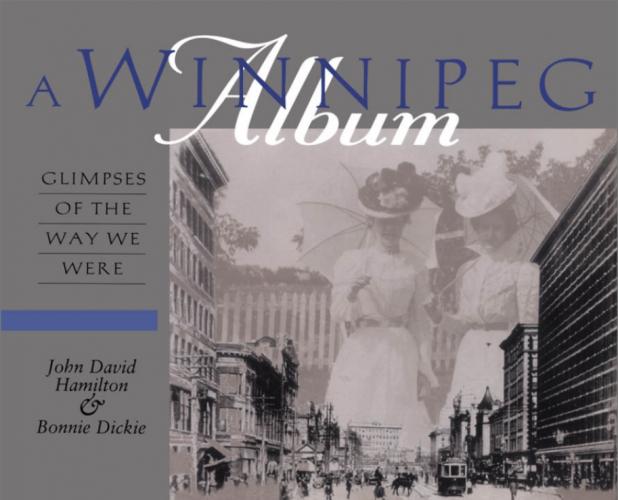WINNIPEG
Immigrant family of five, women in babushkas, sitting on the street in front of the CPR station (1905).
Provincial Archives of Manitoba - Immigration Collection - N7935
Monument commemorating the Seven Oaks Massacre of 1816 (West Kildonan).
Provincial Archives of Manitoba - Foote Collection - N2050
GLIMPSES OF THE WAY WE WERE
John David Hamilton & Bonnie Dickie
Copyright © John David Hamilton and Bonnie Dickie 1998
All rights reserved. No part of this publication may be reproduced, stored in a retrieval system, or transmitted in any form or by any means, electronic, mechanical, photocopying, recording, or otherwise (except for brief passages for purposes of review) without the prior permission of Hounslow Press. Permission to photocopy should be requested from the Canadian Reprography Collective.
Publisher: Anthony Hawke
Editor: Barry Jowett
Design: John Lee
Printer: Transcontinental Printing Inc.
Canadian Cataloguing in Publication Data
Hamilton, John David, 1919-
A Winnipeg album: glimpses of the way we were
ISBN 0-88882-204-9
1. Winnipeg (Man.) — History — Pictorial works. I. Dickie, Bonnie. II. Title
FC3396.37.H36 1998 971.27’43’00222 C98-931585-1
F1064.5.W7H34 1998
1 2 3 4 5 02 01 00 99 98
We acknowledge the support of the Canada Council for the Arts for our publishing program. We also acknowledge the support of the Ontario Arts Council and the Book Publishing Industry Development Program of the Department of Canadian Heritage.
Care has been taken to trace the ownership of copyright material used in this book. The author and the publisher welcome any information enabling them to rectify any references or credit in subsequent editions.
Printed and bound in Canada.
Printed on recycled paper.
Hounslow Press
8 Market Street
Suite 200
Toronto, Canada
M5E 1M6
Hounslow Press
73 Lime Walk
Headington, Oxford,
England
OX3 7AD
Hounslow Press
2250 Military Road
Tonawanda NY
U.S.A. 14150
“. . . why, Winnipeg is the REAL
Camelot! Built faster
than the original and never
collapsed either!”
— son of a Manitoba pioneer.
INTRODUCTION
1881 WAS THE YEAR of the showdown at the OK Corral in Tombstone, Arizona, and the year when Sitting Bull returned to the United States after five years sanctuary in Canada following the Battle of the Little Big Horn.
More important, it was the year of the Winnipeg railroad boom when Canadians seriously began building the CPR and settling the prairies. In many ways, Winnipeg was the most turbulent town on a wild frontier because it was the single gateway to the Canadian West — the only comparable American entrance ports were Kansas City and St. Joseph, Missouri. Winnipeg prepared the way for Regina, Saskatoon, Edmonton, Calgary . . . even far-off Vancouver. This was Camelot, one of a hundred Camelot’s about to rise on the prairies between the North Saskatchewan River and the Rio Grande, and the Red River of the north and the Red River of the south.
It was a time of rugged frontiersmen whether they were aboriginal Indians, Metis buffalo hunters, or navvies on the railroad.
Winnipeg had as much colour as Kansas City, Denver, or Omaha, and in our own history it was more important than any of these cities were in the development of the United States.
But what made Winnipeg and its North American counterparts different was that the prairies were opened at the time of the greatest technological revolution in the history of mankind, which saw the emergence of railway and steamboat travel, the telegraph, the telephone, the electric light bulb and the electric motor, the internal combustion engine, and the airplane.
The Red River Rebellion came in 1869, before the Selkirk Settlement at the Forks of the Red and Assiniboine had established a real town. There were a few settlers and a few long-sighted hustlers who saw possibilities in the future and were determined to steal a stake from the Indians and Metis. Their prototype was Dr. John Schultz, villain or hero, who fought Riel and ended up a knight and lieutenant-governor of the province. Manitoba was already a part of the new nation of Canada when Crazy Horse killed Custer in 1876.
The CPR set up shop in Winnipeg in 1881, and from then on the city’s future was mapped out.
As for my family, my grandfather, Dave Hamilton, a gawky, twenty-two-year-old Ontario farm boy, came to Winnipeg first in 1881. He said there were 100,000 people when he arrived and only 10,000 when he came back during the bust a few years later. Both were exaggerated figures, but he had already embraced the big brag fashion of the west. My father, at 13, lived in a “soddy” on the bald prairie in 1900 while the homestead house was being built. I was conceived on a bush cattle ranch north of Winnipeg in 1919.
So my western ties go as deep as any white man’s, apart from the French-Canadian voyageurs and the Selkirk Settlers.
Wagons at Portage and Main — before there was a city to go with them (1872).
PAM - Winnipeg Streets Collection - N5774
American covered wagons heading west — in Canada (1880).
PAM - Immigration Collection - N7933
The village grows (1874).
PAM - Stovel Advocate Collection - N10213
Parking was easy on Main Street (1883) . . .
PAM - Transportation Collection
